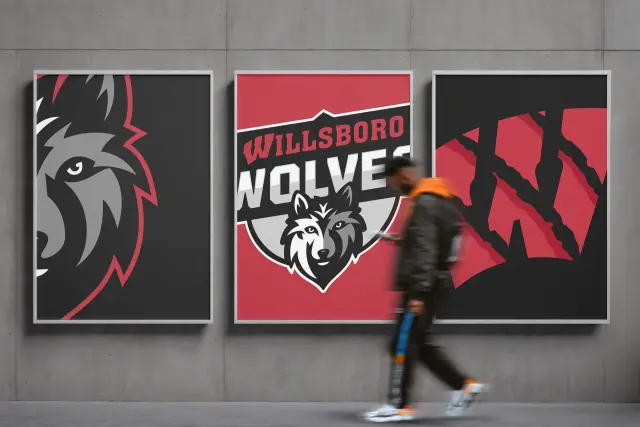School Branding Blog
The Psychology of School Colors: How Color Choices Impact Enrollment and School Pride

Color is one of the most powerful tools in school branding, yet many administrators underestimate its psychological impact on enrollment decisions, student engagement, and community pride. The colors you choose for your school’s identity don’t just look good—they communicate values, influence emotions, and directly impact how families perceive your educational institution.
The Science Behind Color Psychology in Education
Research in educational psychology reveals that colors significantly influence:
- Parent perception of school quality and values
- Student engagement and academic performance
- Community pride and school spirit
- Enrollment decisions during school choice periods
How Parents Process School Colors
When parents research schools, they make split-second judgments based on visual cues. School colors are among the first elements they notice, and these colors trigger immediate psychological responses:
Blue conveys trust, stability, and academic excellence—ideal for schools emphasizing rigorous academics.
Red suggests energy, passion, and competitive spirit—perfect for schools with strong athletic programs.
Green represents growth, nature, and innovation—excellent for schools focused on environmental education or progressive learning.
Purple indicates creativity, wisdom, and excellence—ideal for arts-focused or academically prestigious institutions.
Understanding these color associations is just the beginning. To create a comprehensive brand strategy, schools should also consider how typography choices influence parent trust and the psychological impact of school names.
Color Psychology by School Level
Elementary School Colors
Primary colors (red, blue, yellow) work exceptionally well for elementary schools because they:
- Appeal to young children’s natural preferences
- Create excitement and energy
- Support early learning and development
- Build strong emotional connections
Example: Flora Ridge Elementary School uses vibrant red and gold to create an energetic, welcoming environment that appeals to both students and parents.
Middle School Colors
Bold, confident colors help middle schools navigate the challenging adolescent years:
- Build identity during developmental transitions
- Create differentiation from elementary schools
- Support emerging independence
- Appeal to both students and parents
Example: Horizon Middle School uses dynamic gold and black to symbolize growth and achievement during the critical middle school years.
See These Color Strategies in Action

Henderson Collegiate Strategy & Complete Branding
Henderson, North Carolina

St. Cloud Middle School | School Branding Agency
Client: St. Cloud Middle School Location: St. Cloud, Florida Project: Mustang Mascot & School Identity School Type: Middle School School District: Osceola County School District

Flora Ridge Elementary School | School Branding Agency
Client: Flora Ridge Elementary School Location: Kissimmee, Florida Project: Phoenix Mascot & Arts-Integrated Identity School Type: Elementary School School District: Osceola County School District
High School Colors
Sophisticated, mature palettes reflect the academic and social growth of high school students:
- Convey academic excellence and college readiness
- Support athletic and extracurricular programs
- Create alumni pride and tradition
- Appeal to college-bound families
The Enrollment Impact of Color Choices
First Impressions Matter
Parents form opinions about your school within the first 7 seconds of seeing your materials. School colors are a primary factor in these initial judgments:
Positive Color Associations:
- Blue: Trustworthy, professional, academically strong
- Green: Progressive, environmentally conscious, growth-oriented
- Navy: Traditional, prestigious, established
- Gold: Excellence, achievement, success
Color Combinations That Work:
- Navy and Gold: Classic, prestigious, timeless
- Forest Green and White: Natural, clean, progressive
- Burgundy and Gray: Sophisticated, academic, mature
- Royal Blue and Silver: Modern, innovative, tech-forward
Avoiding Color Psychology Pitfalls
Colors to Use Carefully:
- Bright Orange: Can appear unprofessional or too casual
- Neon Colors: May seem immature or lack sophistication
- Too Many Colors: Creates confusion and dilutes brand impact
- Trendy Colors: May become outdated quickly
Case Studies: Color Psychology in Action
Success Story: Henderson Collegiate
Henderson Collegiate’s navy and gold color scheme conveys:
- Academic excellence and college preparation
- Traditional values with modern innovation
- Professional credibility for college admissions
- Alumni pride and institutional tradition
Result: 28% increase in enrollment inquiries after rebrand implementation.
Success Story: St. Cloud Middle School
The mustang-themed gold, black, and maroon palette creates:
- Strength and determination for middle school students
- Energy and movement for athletic programs
- Sophistication that appeals to parents
- Memorable identity that stands out in the district
Implementing Color Psychology in Your School Brand
Step 1: Define Your School’s Personality
Before choosing colors, identify your school’s core values:
- Academic excellence vs. holistic development
- Traditional vs. innovative approaches
- Competitive vs. collaborative culture
- Community-focused vs. individual achievement
This foundational work aligns with strategic brand positioning and should be part of your overall school brand audit process.
Step 2: Research Your Competition
Analyze color choices of nearby schools:
- Avoid identical color schemes
- Find opportunities for differentiation
- Consider regional color preferences
- Identify gaps in the market
Step 3: Test Color Combinations
Primary Color: Choose one dominant color that represents your core values Secondary Color: Select a complementary color for variety and depth Accent Color: Add a third color for highlights and special applications
Step 4: Consider Application Contexts
Ensure your colors work across all applications:
- Print materials: Letterhead, brochures, signage
- Digital platforms: Website, social media, email
- Athletic uniforms: Sports teams, spirit wear
- Facility branding: Building signage, interior design
The ROI of Strategic Color Choices
Schools that invest in strategic color psychology see measurable results:
- 15-25% increase in enrollment inquiries
- Improved brand recognition in the community
- Enhanced school spirit and student engagement
- Stronger alumni connections and fundraising
Explore More Color Psychology Examples
Next Steps: Implementing Your Color Strategy
Ready to harness the power of color psychology for your school? Start by:
- Auditing your current colors - Are they aligned with your values?
- Researching parent preferences - What colors resonate with your target families?
- Testing color combinations - Get feedback from stakeholders
- Planning implementation - Create a rollout strategy
Related Resources
- How School Branding Influences Parent Choice: The complete psychology guide
- School Branding That Drives Enrollment Growth: Strategic implementation
- Complete School Mascot Design Process: Visual identity creation
Ready to transform your school’s visual identity with strategic color psychology? Get your custom branding estimate and discover how the right colors can drive enrollment and community pride.
Mascot logo design
Get an enrollment-ready mascot your community loves
Start with our mascot logo design service. We’ll craft a distinctive, on‑brand mascot system and rollout plan tailored for your school.
Start your estimateRelated
Charter School Branding - Mascots, Identity & Enrollment | 250+ Projects
We help charter schools build mascots and identity systems that rally communities and support enrollment. See packages and proof.
View detailsRelated
Mascot Logo Design
Identity systems that boost spirit and adoption.
View details


